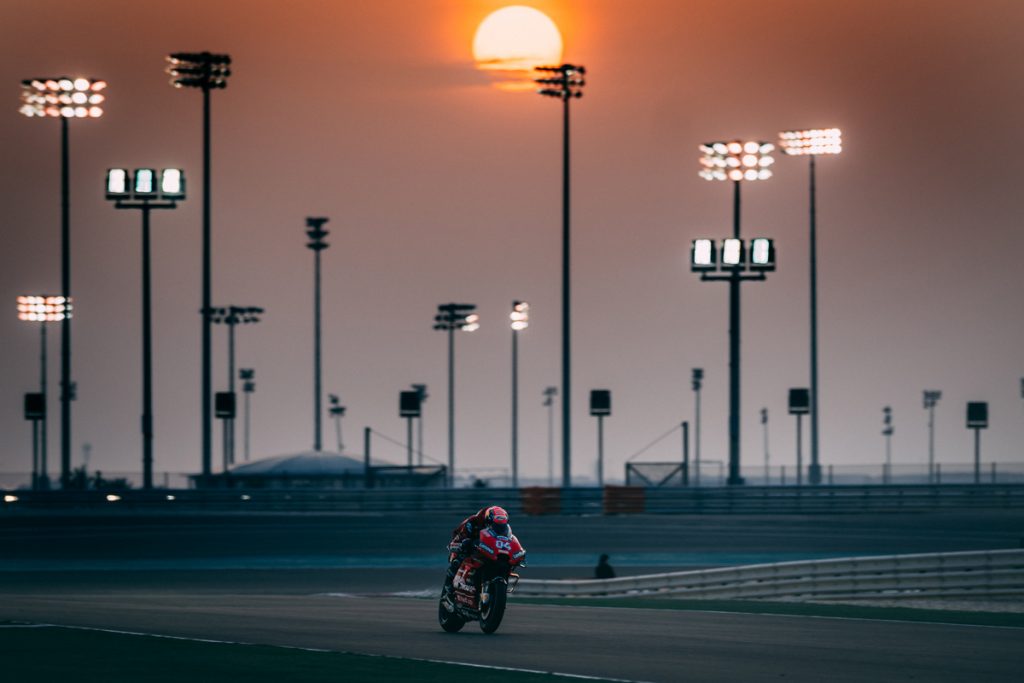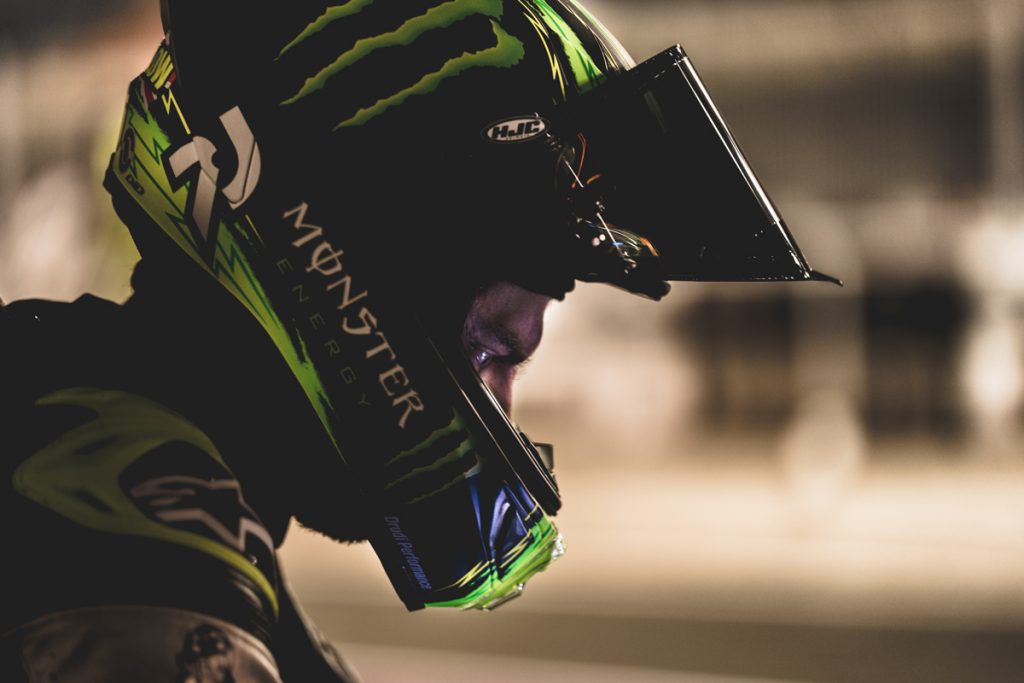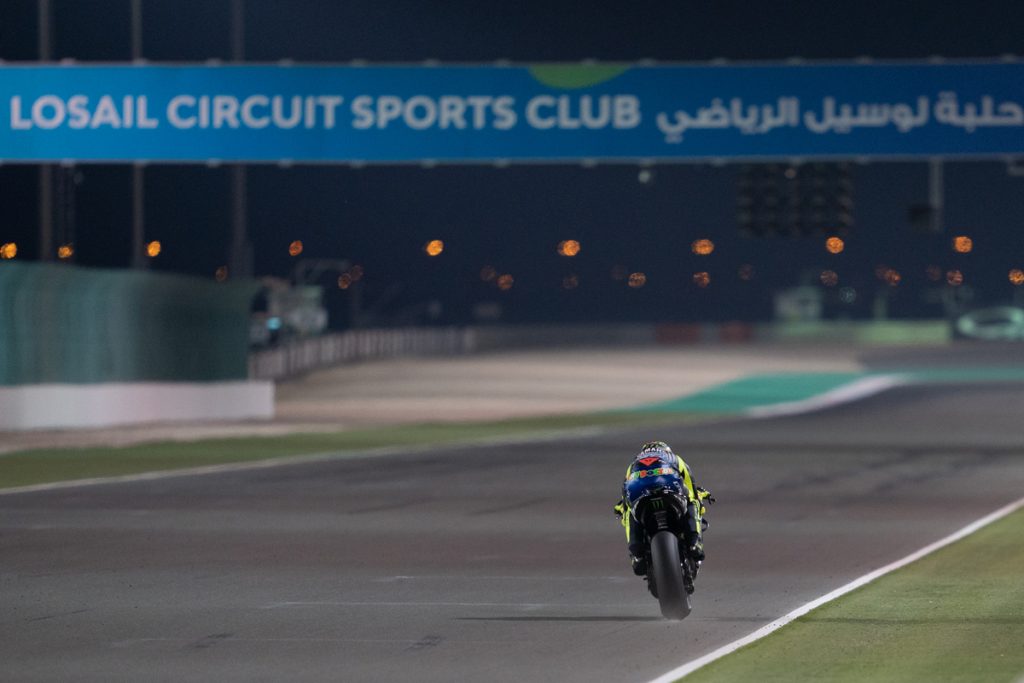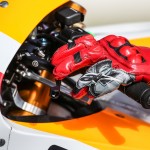Six days of testing into the MotoGP pre-season and with the curtain raiser just over a week away it’s time to draw up some hasty conclusions. In some respects, a weekend in the Qatari desert gave Marc Marquez a broad idea of who will be challenging for his crown and confirmed a number of suspicions from Sepang.
Namely that Monster Yamaha’s Maverick Viñales is probably in the best shape of them all, posting the fastest time of the test – 1m 54.208s – and backing up that early promise at Sepang. He’s fast everywhere: different circuits, in different temperatures, in varying levels of grip. Alex Rins has proved an able back-up, nearly matching his countryman’s consistency, and showing Suzuki’s GSX-RR remains a regular podium threat – if not better.
Then there was Marquez. Two and a half months on from a “complicated, aggressive” four-hour rebuild on a left shoulder that was dislocating at an alarming rate, the reigning champion upped the ante after day one. By Monday he posted more laps in the mid/low 1m 55s (31) – around last year’s race pace – than anyone. And that shoulder faced its first considerable test since his return in early February. A fast crash at turn six provided a scare. “I tested it well,” he said on Monday. “And it’s OK. It’s ready to fight!” Confirmation that seemed to spur his enthusiasm.
Fabio Quartararo has been 2019’s revelation to-date. The deep well of talent hidden within the grid’s youngest entry has never been in question. Here he quickly addressed the braking issues he encountered in Qatar. “I turned my brain off and said: ‘let’s see what happens in the braking zone,’ he said matter-of-factly. But what really surprised was his consistency. Take his 20 fastest laps from days two and three, and Quartararo’s average was only surpassed by Viñales, Rins and Marquez. Surely, at 19 years old, he couldn’t replicate countryman Johann Zarco’s sensational rookie feats of 2017 at this very track… Could he?

Yet as with most pre-seasons a number of question marks remain. By the lofty standards set in the summer and autumn of 2018, Ducati wasn’t quite hitting the heights of past tests. Danilo Petrucci (tenth) was the only Bologna bike to scrape into the top ten.
Honda’s another one. Take Marquez out of the equation and Jorge Lorenzo and Cal Crutchlow’s regularity was sorely lacking. And then what of Valentino Rossi, now in his 40th year and fast approaching a 20th consecutive premier class campaign? 5th on day one. 19th and “a bit worried” on day two. But back and fighting in 4th on Monday – a rollercoaster of a test, surmised by words less bathed in the careful optimism of his young teammate.
To start, Ducati must top that list after a curious three-evening spell under the floodlights. At this test a year ago Andrea Dovizioso was cruising. Never outside the top three, the Italian was ready to race from the very first evening. But this week he was rarely close to the fastest, managing 8th on Sunday before ending Monday a distant 15th (yes, in 2019 even 0.997s back of Viñales is ‘distant’).

Dovizioso’s feeling on day three was “not 100 percent.” A heavy wind on the final day forced him into adopting slightly altered lines and braking markers. Both he and Petrucci underwent a race simulation together on the final night, only for the #04 to drop out after 15 laps of running due to front tyre issues. “I lost a little bit of feeling, and we tried a lot of things so we don’t have the situation very clear,” he later said. Petrucci had two soft tyres left in his garage at the end of running, showing he forewent a time attack. Dovizioso surely declined to show his hand.
And while the results weren’t spectacular of their longer runs, Ducati had decided on engine and chassis choice as early as Sepang. Also consider this: the simulations and long runs conducted behind one another has been ample practice for racing conditions. We witnessed freight-train races, consisting of a lead group of four or more riders, at 6 of the 19 outings last year.
In those conditions front tyres can overheat. Bikes react differently. “When you make a lot of laps alone it’s one story,” Dovizioso explained on Monday. “When you have to fight and follow somebody it’s a different story. If you are able to simulate that, it’s just something more that nobody did … we can create a very similar situation to the race [and] we wanted to be ready.”
Neither Dovizioso nor Petrucci have given much away in terms of the GP19’s strengths. But it appears it retains the power-heavy characteristics of its predecessor. “We are in the same situation as last year,” Dovizioso said. “Still [the weakness] is the middle of the corner. I think we are in a bit better situation, but maybe some competitors are in a better situation.”
Their tactics didn’t pass Rossi by. “Always Dovizioso is very strong here in Qatar, but also Petrucci was impressive in the test,” noted the 40-year old when asked whom he will be challenging come March 10th.
Honda is another interesting case. In Qatar at least, it appeared Marquez was papering over a few cracks. You may note Lorenzo’s 6th fastest time. But his personal best of 1m 54.653s was his only sub-1m 55 effort. Before he had managed just four laps in the 55s (Viñales did 37 across the three days) – not exactly pace that will see him compete among the podium men next Sunday. “Maybe the first races will be difficult,” he conceded on Sunday. “But little by little we have to be patient and we will get there.”
All agree its new engine has fantastic potential. Consider Marquez’s bike clocked 216mph on the first night, a figure higher even than those posted by Jack Miller (215mph) and Danilo Petrucci’s (214mph) GP19s. As Lorenzo noted “they’ve done an excellent job on the engine. We’re now on the same level as Ducati.”

But there has been an internal acknowledgement Honda is attempting to build a more rounded machine for the year ahead, one less critical on the front end. Crutchlow hasn’t felt comfortable since the moment he swung a healing right ankle over it at Sepang at the start of the month. That continued here, as he was mired in testing new parts, settings and still “not even close” to race set-up.
This isn’t the fault of the factory. Only here was Marquez fit enough over the three days to ride as he normally does. Crutchlow missed both November outings in Spain, where Lorenzo was recovering from his Thailand injuries. And the Majorcan pulled out of Sepang as a consequence of a careless training spill that fractured his left scaphoid.
“We changed a little bit the chassis, but still it’s difficult to understand,” said Marquez of the changes for ’19. “And we saw when the temperature dropped all four Hondas crashed. We still need to work there, to understand why we cannot use soft tyres, and we need to use the hard ones.”
But this is HRC. If they’ve proved anything over the past four seasons, improvements and upgrades are likely to drive their riders forward as the year develops. As Marquez mentioned, “the chassis is something which we can change during the season. So of course it’s important, but it’s not the most important now.” Once Lorenzo’s fully fit and adjusted, there is reason to believe him when he says his potential with this bike is “huge”.

Then comes Valentino Rossi. Always something of an enigma during the winter months, the Italian has somehow been capable of reversing all of the off-season’s wrongs come race one. Be it 2017 or last year, the 40-year old has come home 3rd no matter how concerned the expressions were on his side of the box during testing.
Consider his comments on Sunday night, and you’d be inclined to take early 2019 as another case in point. “A difficult day,” he said. “I was too slow. I always suffer with the rear grip, on the exit of the corner.” And what of Yamaha’s top speed disadvantage of more than 7-8mph to Honda and Ducati? “We are a bit worried,” he said.
Generally, however, the Italian is in good shape. Those troubles on Sunday were the result of “trying a lot of things – maybe too many.” Engineers have yet to set up the electronics to maximise potential on corner exit, as Rossi and Viñales continually stated. But give it time. Now with World Superbike electronics guru Michele Gadda working in their MotoGP ranks, these issues, in theory, shouldn’t be a sticking point through the year. Team manager Massimo Meregalli speaks highly of the engineer’s ability: “What we really need is two more Michele Gaddas… Or three!” he exclaimed.
Viñales has barely altered bike balance since last season’s Grand Prix of Thailand, meaning he can brake as aggressively into the corner. Rossi agrees this area of the M1 is strong. “When I am with the other guys the front of our bike is always good. I like. I have a good feeling. I can push.”
As a consequence of countless false dawns for Yamaha in the previous two years, we must remain sceptical over their chances. Only in the sweltering temperatures of Jerez or Barcelona will we be able to evaluate the true extent of its progress. But, going off this year’s evidence at least, Rossi should be up there, giving Viñales something to think about.
Words by Neil Morrison @neilmorrison87
Photos by CormacGP @cormacgp








